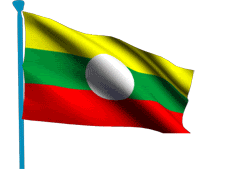THE BUDDHIST TAIS OF INDIA (Part-III)
The Aaitans:
The Aaitans or Aitons are known as the Aitonias by rest of the Assamese. They, before their migration to India/Assam in mid 18th century had lived near the Aitonia Naga villages (in Hukawng valley of Burma) for which they are known as the Aitons. It is possible that they had lived near the Naga settlements; but the name 'Aiton' actually derives from Aiton-Mung or Mung-Aiton. Chaolung Sukapha, during his journey towards Brahmaputra valley had conquered Mungkong (or Mogaung) in the way. Thus he became the master of Mung-Aiton and other principalities of Mungkong. Mung-Aiton was at the Naam-Tayuk valley while Naam-Tayuk is the root river of Dihing. The cause of the migration of the Aitons is political. In mid 18th century, when the Tai kingdoms of upper Burma became subordinate to the Burmese king, many atrocities were imposed on the natives of that region. At this critical juncture, the Aaitans and other Buddhist Tai groups had migrated to the Ahom kingdom of India (crossing the Patkai Hills). At first they settled with the Khamtis at Sadiya, but had later migrated towards south-west. Today, they are found in the districts of East Karbi Anglong (Banlung, Bansai, Banseng, Kalioni and Chowkihola villages) and Golaghat (Tengani, Dubarani and Barhola villages of Borpothar). Their population is between 3000-5000. Some of their clans are- Chiring, Chowhai, Chowpi, Phalung, Thowmung etc. Like the Balijan Vihara (Chong) of the Khamyangs, the Kaliyoni Vihara also bears the testimonials of Assam history. The main Buddha statue (Sutong Pey Phra) of this monastery is believed to be donated by the Burmese general Mingimaha Bandula during his Assam campaigns (1817-1821 AD).
The Turungs:
The Turungs are also branch of the Tai-Shan group. Like the Aaitans, they were also the inhabitants of Mungkong. According to the legends prevailing among the Turungs, they were originally the natives of Mung Mao Song kingdom of Yunnan. They, like other Tais had also migrated to the Hukawng valley. They lived beside a river near the Patkai named 'Nam-Turung' or Turung Pani from which they had earned this name. While living near Nam-Turung, they got invitation from the Khamyangs and thus they had migrated to Assam. But the Singphos captured them on their way. After passing several years in the captivity of the Singphos, an East India Company officer named Captain Neaufville freed them in 1825. Because of their existence in Singpho society for years, many Singpho influences can be seen in their language and customs. Nowadays, the Turungs are found in the districts of Jorhat (Pathārgaon, Pohukotiya and Tipomia or Bagordia villages at Titabor), East Karbi Anglong (Balipothar village at Balipothar) and Golaghat (Bosapothar at Borpothar and No.2 Rajapukhuri at Sarupathār). A small amount of them also live in Arunachal Pradesh (Lohit and Changlang districts). Their population is estimated at 5000. Chowpu, Lubung etc. are some of their clans.
The Phakes:
The Phakes, known as Phakials to rest of the Assamese are also a branch of the Tais from Yunnan. The meaning of the word 'Phake' is still unknown. According to some, Phake means 'King's relative' while some suggests 'people surrounded by rocks'. Whatever it is, the Phakes are Tai and the state left by Chaolung Sukapha is also their paternal land. In about 1760, they left the Hukawng valley and had migrated to the Ahom kingdom under the leadership of Chow Ta-Meng-Khuwen-Meng. He was a member of the royal dynasty of Mungkong (Mogaung). After entering Assam, the Phakes began to live alongwith the Khamtis at Sadiya. Some years later they migrated to the bank of Buridihing (near Nahorkotiya) and had settled there. In 1804 an Ahom officer Chandra Gohain brought them to Jorhat and confined them for their participation in the Khamti Revolt of 1794-99. But during the Burmese invasions, they again went back to the bank of Buridihing. They were about 150 families at that time. Now their estimated population is about 3000. The Phakes are found in the districts of Dibrugarh (Nam-Phake and Tipam-Phake villages) and Tinsukia (Borphake, Mounglang, Manmow villages etc) of Assam. Some of their clans are- Chakhap, Manhai, Thowmung (or Gohain), Toomten etc.
Our next and final historical discussion will be on the Khamtis.
Reference:
1. Tai Sanskritir Ruprekha by Dr. Leela Gogoi
Special Thanks to:
1. Mrs. Ye Hom Burhagohain
Picture Description: The Burmese donated Buddha Statue of Kalioni Vihara (Courtesy by Chow Kensan Tunkhang)




Bolen chawhai
ReplyDelete